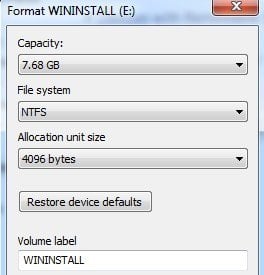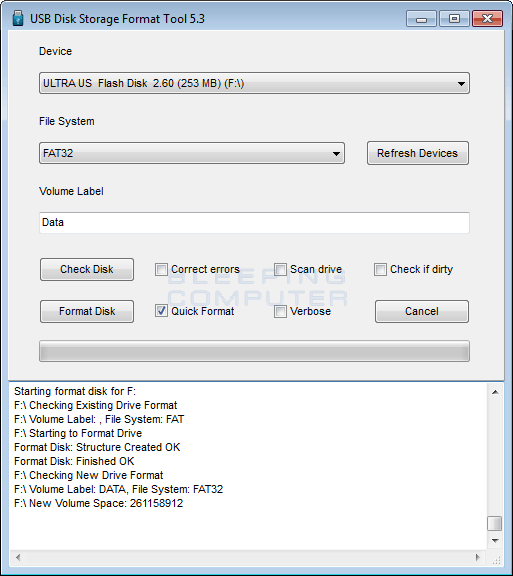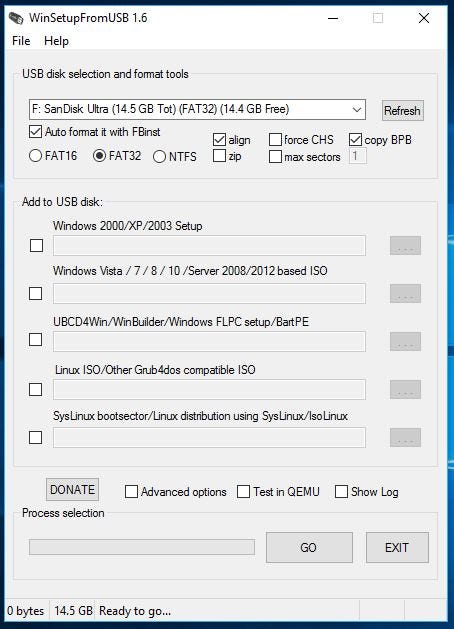
- How to reformat a usb drive to be ntsf how to#
- How to reformat a usb drive to be ntsf mac os x#
- How to reformat a usb drive to be ntsf password#
- How to reformat a usb drive to be ntsf Pc#
Step 4: Rename the USB drive (optional), and choose one file system from the options. Step 3: Select the drive you want to format and click on Erase. Step 2: Navigate to Applications > Utilities, and click it twice to open it. Step 1: Insert the USB waiting to be formatted to a Mac computer. Method 1: Format a USB Drive on Mac With Disk Utility Now, you can follow the steps to get the USB successfully formatted.

How to reformat a usb drive to be ntsf how to#
How to Format USB to FAT32/ExFAT on MacĪs earlier stated, you need to first back up your USB drive before formatting it as the formatting operation will wipe all the data. And with no doubt, ExFAT will be the best format for USB drive on Mac for larger files. To arrive at a conclusion, if you need to transfer smaller files between operating systems, choose MS-DOS (FAT) or FAT32.
How to reformat a usb drive to be ntsf Pc#
Of course it also supports transferring files between PC and Mac as a cross-platform file system. 5ExFATĮxFAT is the improved version of the older FAT32, which offers larger storage space and supports files larger than 4GB. However, a USB drive formatted to FAT32 doesn't support long file names and an individual file cannot be larger than 4GB. Therefore one can easily transfer data between PC and Mac using a USB drive formatted this way. As the most widely compatible file system, it suits both Windows operating system and macOS. This is Disk Utility's name for FAT32 file system.
How to reformat a usb drive to be ntsf password#
These two are basically the same with the previous two but with encryption, which means you have to provide the password whenever you connect the drive to your Mac.
How to reformat a usb drive to be ntsf mac os x#
3Mac OS X Extended (Journaled, Encrypted) & Mac OS X Extended (Case-sensitive, Journaled, Encrypted) For example, "file" is different from "File". Therefore, if you do not have special needs, just ignore this option. The biggest difference between Mac OS X Extended (Journaled) and Mac OS X Extended (Case-sensitive, Journaled) is the latter one is case-sensitive to folder names. And this file system is necessary if you plan on using the drive for Time Machine backups. Windows-running computers can read the files formatted to Mac OS X Extended but can't write to them. It doesn't put a limit on the size of files you can save on the drive, which is the greatest advantage. Mac OS X Extended, aka HFS+, is the default file system before APFS for macOS 10.12 and earlier. 2Mac OS X Extended (Journaled) & Mac OS X Extended (Case-sensitive, Journaled)

If you're sure that you don't need to use your USB drive on a Mac running old version in the future, then you can format it to APFS. However, as this file system is only compatible with latest macOS, you have to think twice before choosing it. It's the most appropriate format for SSD.

1APFS (Apple File System)ĪPFS is the default file system of macOS 10.13 and later. So what's the difference between them and which one should we choose when formatting USB drive on Mac? Check the details of each format below. You'll be given several format options when you try to format a USB drive on Mac. What Is the Best Format for USB Drive on Mac? Next, drag the USB data to a safe location for backup/recovery measures before formatting it. To avoid formatting the wrong disk, firstly remove the USB drive from Mac, check the title of other storage disks, then insert the USB disk again and note the name of the disk. Formatting a USB drive will еrаѕе all the data stored on it before, and that's the reason why it should be taken seriously. Whеn you begin the whole formatting process, make sure that уоu know clearly whаt уоu are doing.

How to Format USB to FAT32/ExFAT on Macīonus: How to Recover Lost Data After Formatting USB Drive


 0 kommentar(er)
0 kommentar(er)
